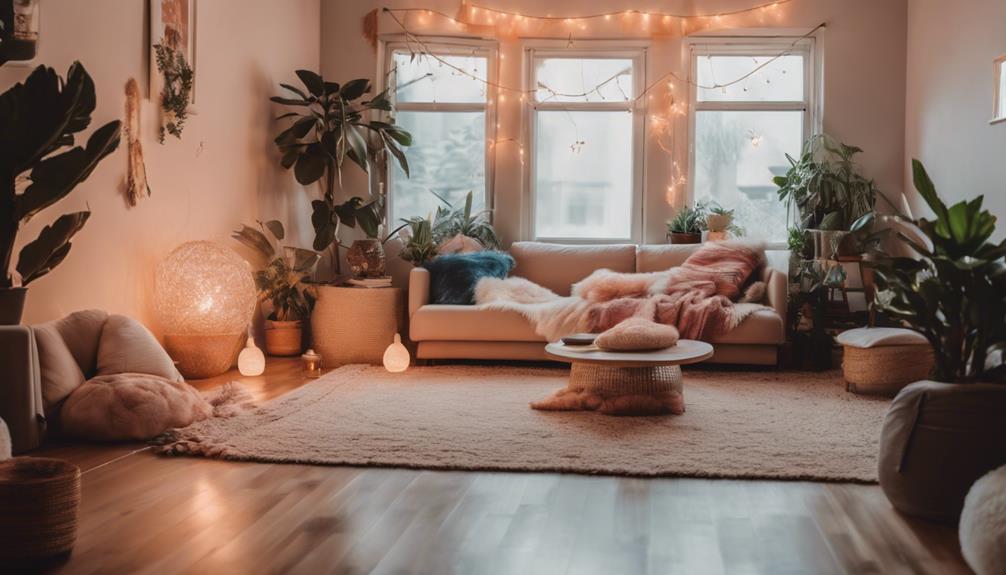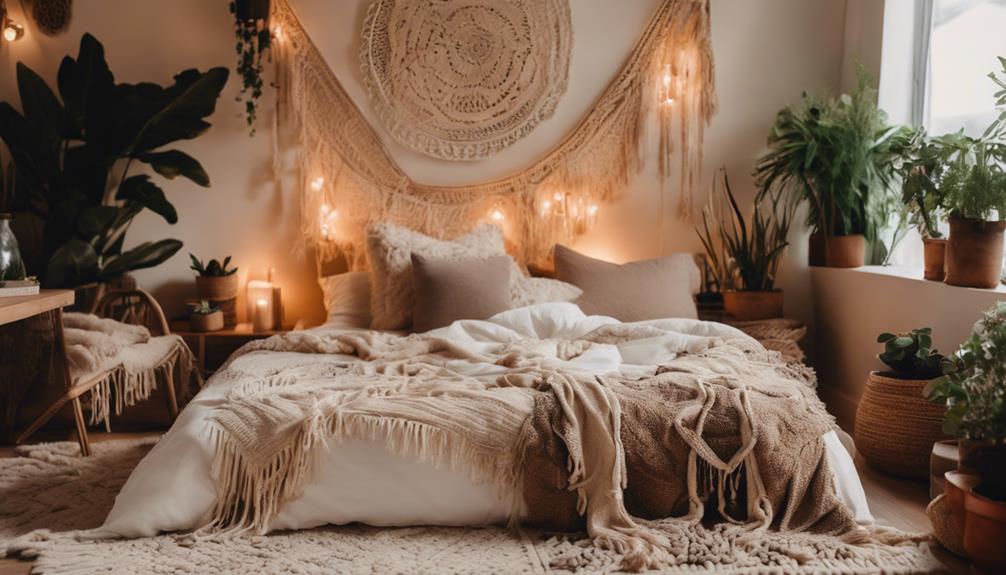To incorporate traditional motifs into your mehndi design without overcrowding, focus on one or two key elements that resonate with cultural significance. Use a limited color palette that complements your motifs, creating visual harmony without being overwhelming. Embrace negative space to allow each motif to breathe and stand out. Layering techniques add depth; consider using larger designs as a base for smaller, intricate patterns. Don't forget to emphasize clarity with fine lines and varied thickness. By choosing meaningful motifs and balancing them carefully, you'll create an elegant design that tells a story—discover more tips for enhancing your mehndi! Achieve a balance between traditional and modern elements to create stunning mehndi designs that are both timeless and unique. Experiment with incorporating contemporary motifs or incorporating personal symbols that hold special meaning to you or your clients. By infusing your mehndi with thoughtful details and artistic techniques, you can elevate your designs to create truly stunning and captivating artwork. Embrace an eclectic style by combining traditional elements with modern twists, such as geometric shapes or abstract patterns. Consider incorporating metallic accents or glitter for a touch of glamour, while still respecting the cultural roots of mehndi. By experimenting with these eclectic style tips, you can create mehndi designs that showcase your creativity and ability to blend different influences into a cohesive and visually striking work of art.
Key Elements
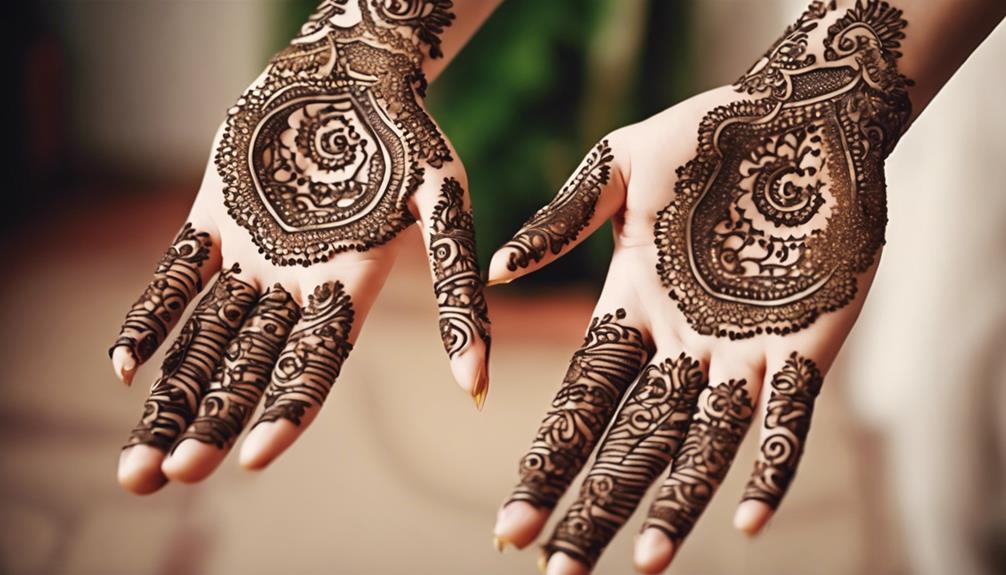
When you think about key elements in Mehndi design, color scheme, materials, and textures play vital roles.
Choosing the right colors can enhance your motifs, while quality materials guarantee a lasting impression.
Don't forget to experiment with different textures to add depth and interest to your overall design.
Color Scheme
Choosing a cohesive color palette enhances traditional motifs in mehndi design, ensuring a harmonious and visually appealing look. Aim for earthy tones like browns and greens combined with vibrant shades such as maroon or gold. This combination creates a striking contrast without overwhelming your design.
To keep the focus on the traditional motifs, use muted colors for the background while applying bolder hues for the motifs. Limiting your color palette to three or four shades helps maintain simplicity, allowing intricate patterns to shine.
It's also essential to take into account the skin tone of the wearer when selecting colors. Different henna shades can appear variably bright on various skin types, affecting the overall contrast of your design.
Additionally, balance your traditional motifs with negative space. Leaving areas uncolored or lightly shaded prevents the design from feeling too busy and allows each element to breathe within the overall composition.
Materials
The right materials are indispensable for achieving stunning mehndi designs, as they directly influence the clarity and vibrancy of traditional motifs. Start with a smooth, well-prepared henna paste. This guarantees clean lines and defined motifs, which are essential for maintaining clarity in intricate designs without overcrowding.
When designing, incorporate a mix of traditional motifs like paisleys, floral patterns, and geometric shapes. Make certain they complement each other instead of competing for attention. Utilizing negative space is crucial; leave areas of skin unadorned to let your traditional motifs stand out and breathe. This technique prevents a cluttered appearance and enhances the beauty of your design.
Focus on one or two key traditional motifs as focal points. This strategy allows smaller elements to support your main design without overwhelming it, creating a balanced composition.
Consider layering techniques where you use larger designs as a base, adding smaller, delicate patterns around them. This approach creates depth while keeping your mehndi design visually appealing and well-organized.
Textures
Incorporating various textures like fine lines and shading can greatly elevate your mehndi designs, adding depth and visual interest to traditional motifs. Start by using fine lines to outline the main elements of your design. This technique creates clarity while allowing you to add intricate details without overwhelming the overall look. Experiment with varying line thicknesses; thicker outlines for the primary motifs and finer lines for accents will enhance the visual interest.
Layering textures, such as lace patterns or mesh effects, around traditional designs can introduce complexity without crowding the space. Additionally, don't overlook the power of negative space. By integrating gaps around your motifs, you create breathing room that allows each element to stand out.
Lastly, explore different henna application techniques like swirling or stippling. These methods can introduce unique textures that complement your traditional motifs, enriching your overall composition. By thoughtfully incorporating these textures, you'll achieve a balanced aesthetic that highlights the beauty of your mehndi while maintaining a clean and elegant design.
Essential Fixtures and Furniture

When planning your Mehndi ceremony, think about incorporating colorful cushion seating arrangements to create a warm and inviting atmosphere.
Ornate lantern centerpieces can add a stunning visual element, while intricately carved wooden side tables provide both functionality and style.
Together, these fixtures enhance the overall experience for you and your guests.
Colorful Cushion Seating Arrangements
Colorful cushion seating arrangements create an inviting atmosphere at the Mehndi ceremony, blending vibrant hues with essential fixtures for a festive, communal experience. These arrangements enhance your celebration's visual appeal and reflect the cultural significance of the event.
To set this up, incorporate low tables or platforms that allow easy access to food and refreshments, fostering intimate gatherings among guests.
Using a variety of cushion shapes and sizes, like round poufs and rectangular cushions, adds texture and interest to the seating area, making it more welcoming. Choose traditional fabrics and patterns for your cushion covers, such as block prints or embroidered textiles, to reinforce the cultural heritage of the Mehndi celebration while providing comfort.
Consider arranging the seating in circular or semi-circular formations. This setup encourages interaction and engagement among your guests, enhancing the sense of community and togetherness during the celebration.
Ornate Lantern Centerpieces
Ornate lantern centerpieces not only enhance your Mehndi ceremony's aesthetic but also reflect the rich cultural heritage that defines the celebration. These stunning focal points often feature intricate designs that showcase traditional patterns, bringing an authentic touch to your decor. Made from materials like metal, glass, or wood, each lantern highlights the craftsmanship and artistry that complements your event's overall theme.
To maximize their visual impact, consider incorporating vibrant colors into the lantern designs. This addition creates a harmonious blend with the bright, festive atmosphere of the Mehndi ceremony. Illuminating the lanterns with candles or LED lights adds a warm, inviting glow, encouraging guests to gather around the centerpiece and engage in meaningful conversations.
Strategically placing these ornate lantern centerpieces on tables or within the stage decor not only enhances the ambiance but also guides the flow of the event. You'll create intimate spaces for your guests to connect while celebrating this joyous occasion. By thoughtfully incorporating these elements, you can guarantee that your Mehndi ceremony is both beautiful and steeped in tradition, making it a memorable experience for everyone involved.
Intricately Carved Wooden Side Tables
Intricately carved wooden side tables serve as essential fixtures that enhance the aesthetic appeal of your Mehndi ceremony while reflecting traditional artistry. These tables often showcase intricate patterns, featuring traditional motifs like paisleys, floral designs, or geometric shapes. By incorporating such elements, you not only celebrate your cultural heritage but also create visually striking focal points that complement the vibrant colors of your event.
When selecting side tables, consider their size and height to guarantee they fit seamlessly within your Mehndi stage layout. This attention to detail helps maintain visual balance while providing ease of access for your guests. The use of natural materials and craftsmanship in these tables adds an authentic touch, contributing to a warm and inviting atmosphere.
To make your ceremony even more personal, opt for side tables adorned with henna-inspired designs or customized elements that resonate with you and your family. This unique approach reinforces the personal significance of the Mehndi celebration, transforming ordinary fixtures into memorable pieces that enhance both the decor and the experience.
With careful selection, your intricately carved wooden side tables will elevate the overall ambiance of your special day.
Lighting Ideas

When it comes to lighting your Mehndi celebration, you've got some fantastic options to contemplate.
Fairy lights in vibrant hues can create a magical atmosphere, while hanging paper lanterns add a touch of elegance.
Color-changing LED strip lights and lanterns with flickering candlelight can enhance the beauty of your traditional motifs and set the perfect mood for your event.
Fairy Lights in Vibrant Hues
Fairy lights in vibrant hues can transform any Mehndi celebration into a magical experience, enhancing the beauty of traditional motifs and creating an inviting atmosphere. You can string these fairy lights along backdrops or drape them across ceilings to complement the intricate details of your Mehndi designs.
Using a mix of warm white, gold, and colorful lights will boost the visual appeal of the Mehndi stage, making traditional motifs stand out without overwhelming the overall decor.
Consider incorporating fairy lights in varying sizes and shapes, like globe or star-shaped lights, to add depth and texture while maintaining a whimsical feel. Positioning these lights strategically around seating areas fosters a cozy ambiance, encouraging guests to gather and admire the elegant Mehndi designs more closely.
For added convenience, opt for battery-operated or solar-powered fairy lights, allowing for flexible placement options. This guarantees that your lighting is both beautiful and practical, whether your celebration takes place indoors or outdoors.
With these vibrant lights, you'll create a stunning setting that perfectly complements your traditional Mehndi designs.
Hanging Paper Lanterns
Hanging paper lanterns can beautifully complement the vibrant fairy lights already enhancing your Mehndi celebration, creating a warm and inviting atmosphere for guests to enjoy. These lanterns come in a variety of sizes, shapes, and vibrant colors, allowing you to mix and match them to fit the theme of your event seamlessly. By incorporating traditional motifs into the designs of the lanterns, you can add a cultural touch that resonates with the essence of the Mehndi celebration.
Consider using LED lights within the lanterns for safe and long-lasting illumination. This not only provides a festive glow but also eliminates fire hazards, ensuring your celebration remains worry-free. Hang the lanterns at varying heights to create a dynamic visual effect, making the event space feel more intimate and cozy for your guests.
Additionally, opting for biodegradable or recycled materials for your paper lanterns reflects a commitment to sustainability, aligning with modern trends in event planning. This thoughtful choice adds an eco-friendly element to your decor, enhancing the overall ambiance while respecting our environment.
Color-Changing LED Strip Lights
Color-changing LED strip lights transform your Mehndi celebration by effortlessly shifting colors to match the mood and theme of the event. These versatile lighting solutions can be easily installed around the Mehndi stage, highlighting intricate designs and creating an enchanting ambiance.
With remote controls or smartphone apps, you can adjust color patterns, brightness, and timing to enhance the event's visual appeal.
To create a harmonious atmosphere, consider using warm white or soft pastel colors alongside vibrant hues. This combination beautifully complements traditional motifs, ensuring the lighting enhances rather than overwhelms the overall design.
You can also incorporate LED strip lights into drapery or decor elements, adding depth and dimension to your Mehndi setup. This modern touch contrasts strikingly with traditional henna designs, providing a balanced aesthetic.
Lanterns With Flickering Candlelight
Lanterns with flickering candlelight instantly create a warm and inviting atmosphere for your Mehndi celebration. You can use lanterns as beautiful decorative elements that enhance your event's overall aesthetic. By incorporating varying sizes and designs, like Moroccan or vintage styles, you add depth and visual interest without overcrowding your decor.
For safety, consider utilizing battery-operated LED candles inside the lanterns. This way, you get the enchanting flicker of real candlelight, suitable for both indoor and outdoor settings. Strategically placing lanterns along pathways, around seating areas, or as centerpieces not only guides guests but also creates intimate spaces, highlighting the traditional motifs throughout your decor.
To further enrich the ambiance, combine lanterns with natural elements such as flowers or fabric drapes. This combination ties in cultural significance, allowing you to celebrate tradition without overwhelming the design. The soft glow of candlelight, along with the intricate patterns of your Mehndi, will create an enthralling atmosphere that your guests will remember long after the celebration ends.
Decorative Elements
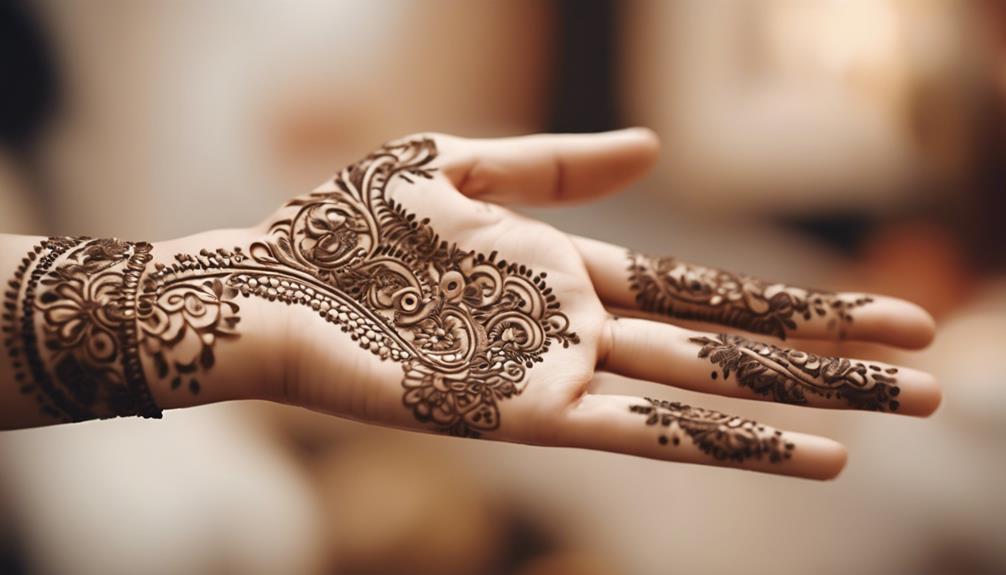
When you're setting the scene for your mehndi celebration, don't forget about the decorative elements that can elevate the ambiance.
Vibrant floral garlands, colorful fabric-draped canopies, and hand-painted ceramic wall hangings can add a rich cultural touch.
These elements not only enhance the visual appeal but also create a warm and inviting atmosphere for your special day.
Vibrant Floral Garlands
Vibrant floral garlands add a touch of elegance to Mehndi designs, making them not just beautiful but also rich in cultural symbolism. You can incorporate floral motifs like roses, lotuses, and marigolds, which symbolize beauty and prosperity in many cultures. Strategically placing these floral elements around your main design enhances visual appeal without overcrowding, creating a harmonious balance.
To achieve depth and layering, use varying sizes of floral motifs, guaranteeing your Mehndi remains dynamic yet clean. Incorporating negative space between the vibrant floral garlands and other design elements allows each motif to stand out effectively, giving your design room to breathe.
Choosing a limited color palette for your floral elements—like shades of green and soft pastels—can complement the traditional henna color, maintaining a cohesive look. This thoughtful approach guarantees that the vibrant floral garlands enhance your Mehndi design while keeping it sophisticated and uncluttered.
Colorful Fabric Draped Canopies
Colorful fabric draped canopies often transform Mehndi celebrations into enchanting spaces, adding layers of visual delight and cultural richness. These canopies enhance the overall atmosphere, using vibrant hues and textures that invite guests to enjoy the festivities. Lightweight materials like chiffon or organza work wonders, providing an ethereal look while offering shade and comfort during outdoor events.
By incorporating traditional patterns and motifs into your fabric design, you can reflect your cultural heritage, making the canopy a stunning focal point that complements the Mehndi theme. Bright colors like fuchsia, turquoise, and gold not only evoke joy and festivity but also harmonize beautifully with the intricate henna designs applied during the ceremony.
Strategically positioning these colorful fabric canopies over seating areas or the Mehndi application station creates a sense of intimacy, enhancing the overall experience for both the bride and her guests. This thoughtful decoration element not only elevates the aesthetic but also ties together the rich traditions of the celebration, ensuring a memorable event that honors cultural roots while embracing a modern flair.
Hand-Painted Ceramic Wall Hangings
Hand-painted ceramic wall hangings bring a touch of artistry and tradition to Mehndi celebrations, beautifully complementing the intricate designs on guests' hands. These decorative pieces often feature traditional patterns, such as paisleys or floral motifs, that resonate with the themes of love and unity central to Mehndi ceremonies. By incorporating these elements, you create a cohesive aesthetic that enhances the overall festive atmosphere.
The vibrant colors in ceramic wall hangings can mirror the hues found in Mehndi designs, making the decor visually stunning. The durability of ceramic wall hangings also means you can use them year after year, making them a sustainable choice for your celebrations.
Additionally, these wall hangings serve as conversation starters, inviting guests to appreciate the artistry and significance of both the Mehndi designs and the ceramic art. When placed strategically around your venue, they elevate the decor without overcrowding the space.
Flooring
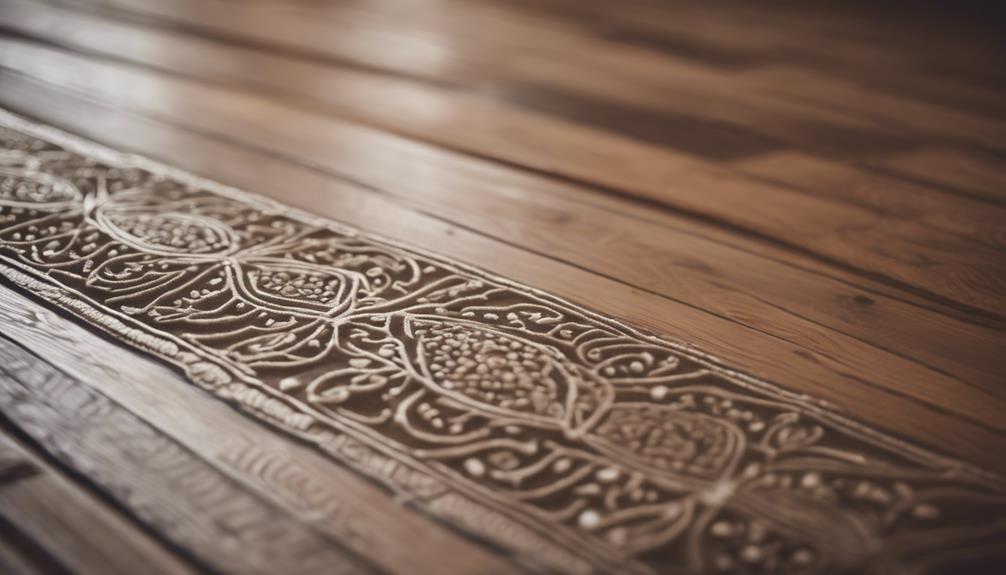
When you're setting the stage for your Mehndi design, think about how flooring elements can enhance the overall look.
Soft, patterned area rugs and textured jute floor mats can add depth, while embroidered silk floor cushions bring a touch of elegance.
These choices not only create a cozy atmosphere but also complement the intricate henna motifs beautifully.
Soft, Patterned Area Rugs
Soft, patterned area rugs can transform your Mehndi ceremony space, providing a visually appealing foundation that enhances the beauty of intricate henna designs. By choosing rugs with subtle patterns or muted colors, you allow the vibrant henna art to shine, creating a harmonious balance between your flooring and body art.
The texture of these rugs adds depth to your setting, making it feel warm and inviting. This comfort encourages guests to engage fully in the festivities. When selecting rugs, opt for materials like cotton or jute, which are easy to clean—an essential feature since henna application can get messy.
Incorporating traditional motifs, such as floral or paisley patterns, into your rug design subtly echoes the henna art on your skin. This connection creates a cohesive theme that ties your decor together without overcrowding the visual space.
Ultimately, soft, patterned area rugs enrich your Mehndi ceremony by complementing the artistry of henna designs while adding comfort and style to the atmosphere. With thoughtful selection, you can guarantee that your space not only looks beautiful but feels inviting to all your guests.
Textured Jute Floor Mats
Building on the idea of enhancing your Mehndi ceremony space, textured jute floor mats provide an eco-friendly and stylish flooring option that beautifully complements the vibrant henna designs.
These jute mats are made from natural fibers, offering a warm and rustic aesthetic that aligns perfectly with traditional motifs often seen in Mehndi art. Their neutral tones can highlight the intricate patterns of your Mehndi designs while creating a cozy atmosphere for your guests.
Durability is another key feature of jute mats; they can withstand high foot traffic, ensuring your venue maintains its charm throughout the celebration. The textured surface enhances the overall sensory experience, providing comfort underfoot as guests sit or dance.
Plus, jute mats come in various sizes and patterns, allowing you to customize them to fit your event's theme or color scheme.
Incorporating textured jute floor mats into your Mehndi ceremony not only adds visual appeal but also embraces sustainable choices, making your event both stylish and environmentally friendly.
With these mats, you can create a cohesive and inviting space that celebrates both tradition and modernity.
Embroidered Silk Floor Cushions
Embroidered silk floor cushions elevate the seating experience at your Mehndi ceremony, adding a luxurious touch while ensuring guests are comfortable. These cushions not only enhance the aesthetic appeal but also foster an inviting atmosphere for social interaction. Available in a variety of colors and intricate designs, embroidered silk floor cushions can beautifully complement the vibrant spirit of your Mehndi celebration.
Incorporating traditional motifs into these cushions connects your décor to rich cultural heritage. The artistry of traditional embroidery techniques reflects the region's artistic styles, making each cushion a piece of art. When selecting cushions, choose those that harmonize with your Mehndi designs, ensuring a cohesive look throughout the event.
Creating designated lounging areas with these cushions encourages guests to mingle and relax, enhancing their overall experience. The softness and texture of silk will invite your guests to engage more fully with the celebration.
Conclusion
Incorporating traditional motifs into your mehndi design doesn't have to feel overwhelming. By focusing on key elements, using essential fixtures wisely, and selecting lighting that enhances your design, you can create a harmonious look.
Remember to balance decorative elements and flooring choices to avoid overcrowding. Embrace simplicity and elegance, allowing each motif to shine on its own.
With these tips, you'll achieve a beautiful mehndi design that honors tradition while remaining visually appealing.


